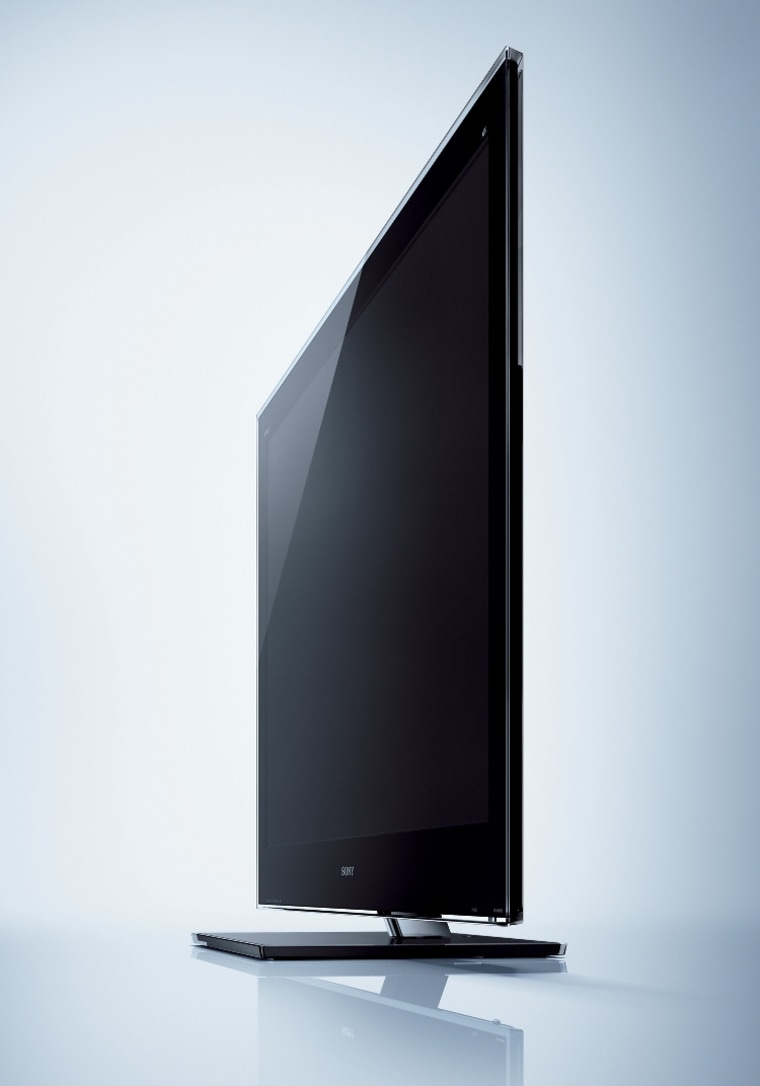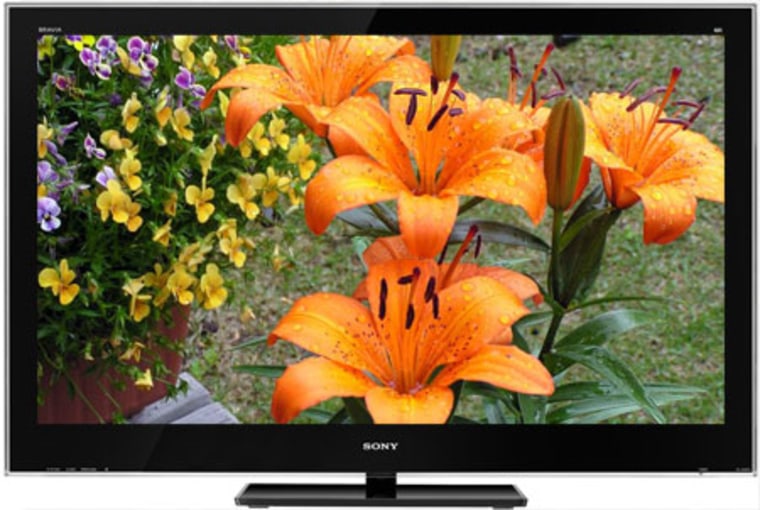High-definition TV sets have moved from the exclusivity of home theater compounds to the living rooms of the rest of us. You can still easily spend thousands of dollars for a top-of-the-line HDTV, but you can also find some fine sets for around $500, especially if you are looking at those with displays of 32 inches or less.
While HDTVs were mainly high-end purchases a few years ago, there are now more different types of HDTVs than ever, which means more shopping choices — but also some shopping confusion.
If you're an HD enthusiast who wants the latest and greatest — which at the moment means sets that use LED backlighting or illumination, those with frame refresh rates of 240hertz and HDTVs that connect to the Internet — you'll pay a premium. If you're looking for a great picture and are willing to pick and choose your set's features, you'll find plenty of candidates.
For example, Sony's new 46-inch Bravia LCD HDTV (KDL-XBR10) uses light-emitting diodes (LEDs), has a top refresh rate of 240 Hz and 1080p resolution and has four HDMI inputs (more on this lingo in a moment), and retails for $4,500.
In contrast, Sony's 46-inch Bravia S Series LCD TV (KDL-46S5100) uses fluorescent lighting, has a refresh rate of 60 Hz, 1080p resolution and 3 HDMI connections. It goes for around $1,100 — $3,400 less than its sibling.
For sure, with technology constantly changing, future-proofing your set — beyond the next six minutes — can be tough. As it is, one out of four American families buys a TV set every year, according to the Consumer Electronics Association, although with the recession, that figure may change.
Smaller screens prevail
HDTV prices are down about 20, and even 30, percent in some cases, from a year ago, said Paul Gagnon, director of North America TV market research for DisplaySearch. Size-wise, he said, 32-inch displays are "far and away the most popular size of TV right now, especially since they've fallen under $500, and are small enough to be used in multiple rooms of the house."
For the living room, 40- and 42-inch screens are common, and displays for bedrooms tend to be between 19- and 22-inches.
Consumer electronics shopping site Retrevo confirms the trend. The company recently noted that a year ago, for every buyer who purchased a 37-inch or smaller display, there was one who bought a larger set of up to 50 inches. Now that ratio has shifted, to three buyers of smaller sets for every two of larger ones, Retrevo says.
No matter what size suits your needs, space or budget, here are some factors to consider when shopping for a "basic" HDTV:
Resolution: Sets that are 1080p (the "p" is for progressive) are considered to have the best resolution, providing 1,920-by-1,080 pixels of resolution, with each frame of video transmitted progressively for a smoother scan. There are also sets that are 720p, providing 1,280-by-720 pixels of resolution.
Displays that are 720p are less expensive, and if you're looking to buy a set that's 37 inches or smaller, a 720p set might work well for you. Some experts believe there's little, if no, difference between the two resolutions in terms of quality, that they both look great. Others feel differently. But most agree that on a smaller screen, it's difficult to discern a 720p picture from one that's 1080p.
HDMI connections: High-Definition Multimedia Interface connections are used for the cables to connect your HDTV to a cable TV or satellite box, DVD player or video game console. HDMI transmits both uncompressed audio and video signals. A year or so ago, HDTV sets had one and sometimes two HDMI connections. Now, two is OK; three is typical and higher-end sets have four and sometimes more. How many you need will depend on how many devices you want to connect to your TV.
"It’s even useful to have one of those HDMI connections located on the front or side of the TV, because a lot of consumer camcorders now come with an HDMI connection," Gagnon said. "So for hooking up and playing video back from your camcorder through your TV, it’s very helpful to have an HDMI jack where it’s accessible."
PC and USB inputs are also useful to have for connecting other devices, as is built-in SD card reader for photographs from your camera that you might want to show on your set.
Refresh rate: This is not the speed at which you run to the fridge for beverages during a football commercial. Refresh rate, sometimes also called "frame rate," means the number of times per second that an image on the screen is refreshed, as measured by hertz.
A refresh rate of 60 Hz is considered "normal" on most sets, Gagnon said; 120 Hz is an upgrade, and this season, 240 Hz is the hot number. "The biggest benefit is that it reduces the kind of motion blurring that you traditionally get with LCD TVs for fast-moving action, so things like sports tend to benefit from higher frame rates, but even movies, too.
"For the most part, 120 Hz is available on a pretty broad range of models, probably from the middle tier on up," he said. "And then 240 Hz is a pretty premium feature that is found on the upper-crust models from most manufacturers."
LED: New to consumers this season are LCD HDTV sets that use light-emitting diodes to backlight or illuminate the display, offering deeper blacks and more even vivid colors than LCD sets that use fluorescent lighting. Using LEDs not only means less power consumption, but the ability to build TVs that have supermodel-like thinness to them.

Samsung's LED sets are among the thinnest at 1.2 inches because the company places LEDs on the set's perimeter instead of behind the display.
"A lot of people are attracted to those thin designs, and are also looking to save on power consumption," Gagnon said. "But these sets tend to be more expensive. LEDS are more costly to use for backlight than the fluorescent type of lights."
Internet-connected TV: Most new HDTVs have an Internet Ethernet connection — "that’s pretty common to find these days," said Gagnon.
How you use that connection is up to you. It's good to have it (future-proofing), but you don't need to do anything with it unless you want to.
With "connected television," as it's called by many manufacturers, "you hook up your TV to your household Internet connection, so it can reach out to the Web and pull in a variety of different content," Gagnon said.
That content ranges "from simple widgets, to more complex content like social networking — think Facebook or Twitter on your TV — all the way up to the most advanced type of Internet content, video streaming to your TV from pay-service sites like Netflix or Amazon, but also possibly, free sites like YouTube or Hulu," he said.
"Some sets are hard-wired so that you have to run an Ethernet (high-speed Internet) cable from your home wireless router to your TV," he said. "But others will actually have built-in wireless connectivity so that if you have a wireless home network set up, you can connect the TV directly with that wireless router."
Wireless HDTVs: As sets get slimmer, those thick cables streaming from behind the sets detract from the look of the set and add to electronics clutter in a room. If this doesn't bother you, you're good to go for the future.
But for those who care, and are willing to spend the money, wireless HDTVs are just starting to come on the market. "The first with integrated wireless that I know of are launching probably toward the holiday period," said Gagnon.
Expect such sets to be at the pricier end of the scale.
An industry group, known as The WirelessHD Consortium, has been working on standards to make sure that HD sets can communicate correctly with equipment such as cable boxes and DVD players.
"The availability of the WirelessHD compliance test and test equipment is a key enabler in accelerating the availability and adoption of WirelessHD technology," said John Marshall, president of the consortium, in a recent statement.
